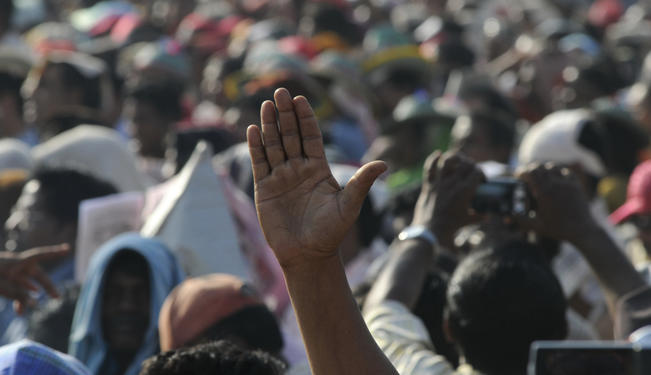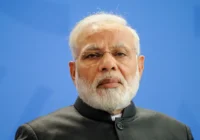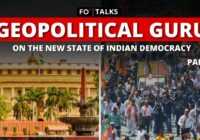Amid upheaval with India's domestic politics, will a third front emerge in the next election?
India’s United Progressive Alliance (UPA) II government has become highly unstable. Elections may be declared at any time. When this happens, the coalition groupings at the national level are likely to change. There is a distinct possibility that a third front of regional parties will emerge. This grouping could include the Janata Dal United (JDU); All India Anna DMK (AIADMK); Samajwadi Party (SP); Trinamul Congress (TMC); Shiromani Akali Dal (SAD); Telugu Desham Party (TDP); Biju Janata Dal (BJD); Assam Gana Parishad (AGP); National Conference (NC); Indian National Lok Dal (INLD); among others. If such a grouping emerges at the national level, it will be very powerful.
The Groupings
The present groupings will continue as long as the regional parties want to postpone the elections. Once they find themselves prepared for elections, and feel that elections are inevitable, they will withdraw support from the UPA. The Food Security Bill, intended to provide food grains to more than half the Indian population at highly subsidized rates, is not likely to be passed during the term of the present Lok Sabha (lower house of parliament), as it would give the Congress Party an accomplishment to cite in the general election — something opposition parties are keen to prevent. However, a few financial bills close to the finance minister’s heart, like the insurance and pension bills, may be passed with the support of the Bharatiya Janata Party (BJP) after amendments desired by the political party are made.
The Bahujan Samajwadi Party (BSP) and Samajwadi Party (SP) are rivals in Uttar Pradesh, the largest state in India, and cannot be on the same side of the fence at election time. Hence the SP is likely to be in the third front and the BSP will continue as an ally of the Congress.
Similarly, the All India Anna DMK (AIADMK) and DMK, being rivals in Tamil Nadu, cannot be together. Jayalalitha could join the third front and the DMK might again come to an understanding with the Congress on contesting elections together. The Trinamul Congress (TMC) and the Left do not see eye to eye. But Mamta Banarjee, leader of the TMC, has to be an integral part of any third front, so the only option available to the Left would be to fight it alone in the elections.
The SAD of Punjab, BJD of Orissa, TDP of Andhra Pradesh, NC of Jammu and Kashmir, AGP of Assam, and INLD of Haryana, could join the front. Sharad Pawar, in retirement, may decide to pull his party out of the UPA and join the third grouping. Thus, the third front would emerge as an overarching group at the national level.
The UPA and NDA would both disintegrate in this scenario. Most of the BJP’s allies would join the third front and party would be left alone. At best, Shiv Sena would be the only party to support the BJP. For Congress, the blow could be a little less severe. Mayawati, leader of the SP and Karunanidhi, leader of the DMK, may continue as allies of the Congress. Though the UPA may not remain intact, Congress may retain support from some of its old allies. The DMK may continue to support the Congress since the AIADMK would be in the third front, and the BSP may continue its support since the Samajwadi Party would be with the third front.
Visualizing the Scenario
Under such a scenario, let us visualize the election’s outcomes. The third front will have emerged as a powerful force. And, if all goes well for the grouping, it will be in a position to secure an absolute majority in the Lok Sabha. There are several states, such as Bihar, Tamil Nadu, Uttar Pradesh, West Bengal, Orissa and some of the smaller states, where the prospects for the third front would be excellent. I estimate that the third front will win about 175 seats in these states out of a total of about 250 seats. These are all states where the regional parties, who are likely to join the third front, are ruling after winning a majority. In states such as Maharashtra, Karnataka, Assam, Andhra Pradesh and several small states, the third front is estimated to win a moderate 60 seats out of a total of about 150 seats. In states such as Madhya Pradesh, Rajasthan, Kerala, Gujarat and certain small states, the third front is projected to win a meager 40 seats out of a total of about 150. This makes a total of 275 seats for the third front, which would provide it with an absolute majority in the Lok Sabha whose total strength is 550, excluding two nominated members. The BJP, without its allies, would become very frail and may be able to garner only about 80 seats. The Congress and its allies may do only a shade better with 120 seats. The left front in this scenario may manage to win 20 seats, and the newly formed Aam Admi Party may win only three seats.
All talk of Modi versus Rahul in the prime ministerial race would disappear into thin air. The third front would also have difficulty finding a suitable candidate. The contenders will include Jayalalitha (AIADMK), Mamta (TMC), Nitesh (JDU), Mulayam (SP), and so on. Maybe the front will decide that the regional party emerging most successful in the elections will nominate its leader as PM.
How will such a third front government, elected with an absolute majority, fare in the matter of governance? The results will be mixed. On the non-economic side, the front may be able to achieve commendable results. But on the economic side, the driving force of the front is likely to be populism, and the nation will slowly descend into economic difficulty. Finally, when the front completes its full term, an economic crisis could emerge. Perhaps at this stage the Indian public may once again demand the services of the Congress Party to deal with the destitute state of the economy.
The views expressed in this article are the author's own and do not necessarily reflect Fair Observer’s editorial policy.
Image: Copyright © Shutterstock. All Rights Reserved
Support Fair Observer
We rely on your support for our independence, diversity and quality.
For more than 10 years, Fair Observer has been free, fair and independent. No billionaire owns us, no advertisers control us. We are a reader-supported nonprofit. Unlike many other publications, we keep our content free for readers regardless of where they live or whether they can afford to pay. We have no paywalls and no ads.
In the post-truth era of fake news, echo chambers and filter bubbles, we publish a plurality of perspectives from around the world. Anyone can publish with us, but everyone goes through a rigorous editorial process. So, you get fact-checked, well-reasoned content instead of noise.
We publish 2,500+ voices from 90+ countries. We also conduct education and training programs
on subjects ranging from digital media and journalism to writing and critical thinking. This
doesn’t come cheap. Servers, editors, trainers and web developers cost
money.
Please consider supporting us on a regular basis as a recurring donor or a
sustaining member.
Will you support FO’s journalism?
We rely on your support for our independence, diversity and quality.







Comment